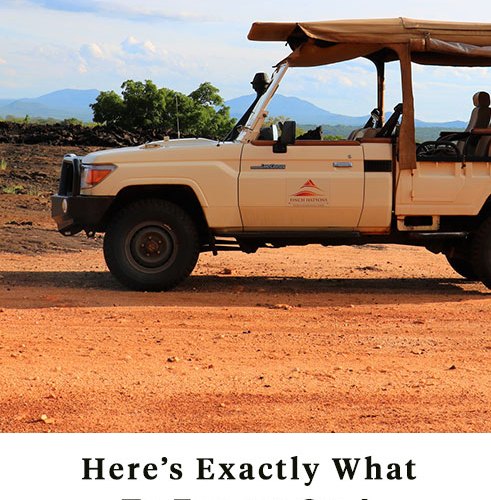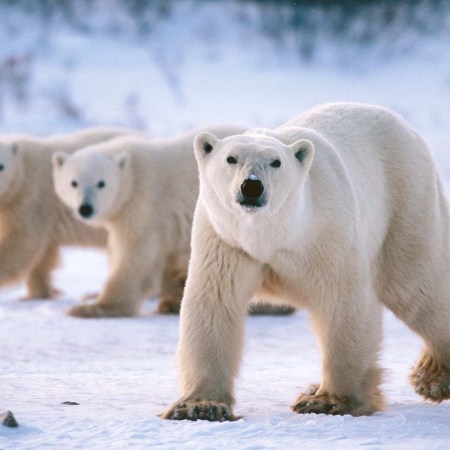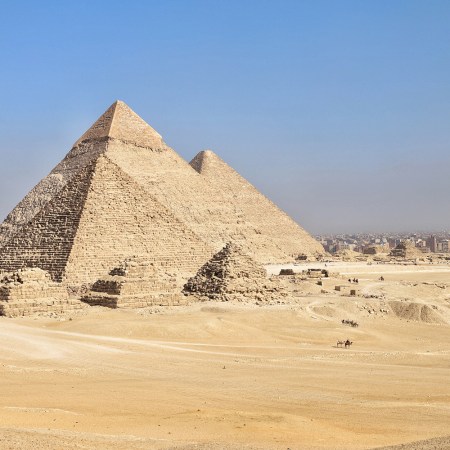Cracking open a cold Tusker beer — Kenya’s long-serving staple lager — in the back of a bumpy, custom-outfitted Land Rover while cruising the wide open expanses of a Kenyan national park or game reserve is one of life’s greatest joys. Now, let’s make no mistake about it: Tusker is an entirely mediocre beer. Outside of this quite specific setting, it’s serviceable at best. However, as you pull long sips from a properly chilled bottle fetched from your under-seat cooler, your eyes rapidly searching around brush and scanning the horizon for the cheetahs you’ve been prowling for all evening, well, there’s simply nothing better.
The modern game drive is, of course, a spectator sport; the only shooting you’re doing is with your camera. “Remember, a game drive is a game,” says Evans, my guide at Finch Hattons in Tsavo West National Park. “Sometimes you win and sometimes you lose.”
Such a statement may help to reset your expectations so that you’re not expecting to be wading knee deep through lion cubs in an endless pride parade for the entirety of your journey. No, a safari and its game drives come with long lulls as you meander and maneuver through the terrain, interludes suddenly punctuated by the extreme highs of finding your targeted wildlife. If a game drive is indeed a game, then perhaps it’s most akin to the beautiful game. Like a soccer match, extended periods seemingly devoid of all drama rapidly crescendo into the ultimate decisive action. As soon as your interest begins fading and you surrender hope of success, the wonderfully unexpected occurs.
Evans has been working at Finch Hattons for the past decade, coming from a Kenyan tribe traditionally known for skills such as bow and arrow archery, wood carving and tracking. The latter skill in particular helped launch him into his career as a safari guide. At one point we were cruising mere minutes from the camp’s entrance before he abruptly stopped the vehicle to pull up alongside a trio of trotting zebras. “They look so nervous— there must be something over there,” he said, flashing to his left. As we both switched our perspectives to that side of the vehicle, whoom, suddenly the adult leopard we had been searching for the past two days appeared about two feet away from our tires before retreating under nearby tall grasses.
Besides the incredible sighting, I couldn’t believe how he had pulled off the feat, apparently conjuring a leopard out of thin air based upon the reading of a zebra’s emotional state, while all I had registered up to that point was that, yes, there were three zebras. “Sometimes animals make more sense than people,” Evans said calmly. At least if you know what to look for, and since you assuredly don’t, it’s essential to have such a knowledgeable guide on hand.
Upon departing Tsavo West for the Maasai Mara, and a stay at Richard Branson’s Mahali Mzuri camp in the Olare Motorogi Conservancy, I mentioned to my guide Jackson, a member of the Maasai tribe, that I hadn’t yet seen any lions and I wanted to dedicate as much time as possible to searching for them. “Mmm, you have to see what nature provides, but let’s try,” he said. For his part, he compared a game drive to fishing and biding your time until a catch.
While he didn’t want to make any bold guarantees, he knew precisely where to go, a particular grouping of shrubs favored by one of four local lion prides in the conservancy. Perhaps 20 minutes after making my request, we stopped within grasping distance of a frolicking 14-lion pride, three sisters with three cubs apiece, and two adult brothers snoozing off in the distance. The cubs were incredibly playful and social, the outsized paws of one softly smacking the face of another, as they all rolled around and groomed one another and unleashed their best mini roars, more like shrilly “raaaayyyyrs.” Awake from their midday naps, they wanted nothing more than to rouse their respective mothers for some affection, or more likely, for feeding time. And like all worn out mothers hauling around triplets day in and day out, the lionesses ably ignored their offspring for as long as they could until finally succumbing to their pressure to awaken.
It’s entirely exhilterating to be in the midst of such animals on their turf and their terms. While Kenya is known for the Mara, and Tanzania is known for the Serengeti, it’s crucial to remember that the two are one connected ecosystem. “Before people came and drew lines on maps,” Jackson reminds. The animals you see in one place may move to the other as part of an annual migration or along whichever circuitous journey it happens to undertake throughout its life.
These creatures don’t belong to a country, they aren’t ours. The land is their own, and thankfully, a growing contingent of groups have recognized the fact. That’s what makes the privately run conservancies, in addition to national parks and reserves, so crucial.
In Olare Motorogi, for instance, local landowners receive payments for leasing their land, while animals are given domain to come and go as they please, free from human interference. And within the conservancy, at a camp such as Mahali Mzuri or Finch Hattons, there’s no fence or barrier separating what is the camp and what isn’t. You may be in a luxury tent with a plush king size bed, leather couch, and stocked wet bar, but you are still in the bush. At night, you’re mandated to have an escort walk you back to your room, because you don’t know what you’ll find along the way; prowling cats, noisy hippos, spooked giraffes and large troops of baboons are just a few of the residents that may be scampering around the same paths as yourself.
The Rhythms of a Luxury Safari
With your adrenaline still pumping afternoon an afternoon of close encounters, you’ll begin to head back to camp before it’s too dark. However, there’s time, always just enough time to squeeze in a sundowner, a nightly ritual allowing you to take in the setting sun across the beautiful landscape, drink in hand, of course. Did you make your request for a bottle of bubbly to be stowed away for just this very moment? Or did you request a quick G&T service out in the wilderness? Another Tusker isn’t out of the question, is it? Ask and you shall receive.
Finch Hattons takes things one step further yet, setting up a full cocktail bar in the bush, with a chef working a cheese board alongside a bartender making your drinks. With a few snacks and sips behind you, step up for a round of rungu, Maasai club throwing. You’re given half a dozen clubs of assorted weights, similar in shape to Irish shillelaghs, and have to toss them into a small ringed target.
I was aces from about 15 feet away, until Isaac, the Maasai in charge of the evening’s festivities, pulled me back to where he shot from, about twice as far as he courteously allowed me to stand for my opening forays. I’d say my accuracy got worse before it got better, but truth be told, it simply got worse and stayed worse. I retreated to my beverage and watched with amazement as he swished one club after another, before learning that when he and his tribe are actually competing — there’s a biennial Maasai Olympics — the official distance is twice further away still.
It’s all part of the rhythmic routine, to which you’ll quickly become accustomed, of life on a luxury safari. Each day begins with an early morning wakeup, as you dose yourself with coffee before heading out for your first game drive. A few hours on the would-be hunt, and it’s back to camp for a hearty breakfast. While away a few hours at the pool or spa, enjoy a leisurely lunch, maybe some afternoon tea, and then it’s out once again for your evening run. Let your guide know what you’d most hope to see, get on the move for a few hours, cap the affair with your sunset cocktail and it’s back to camp.
After that (yes, there’s more) it’s time for a rousing round of pre-dinner drinks — ah, excellent, your dedicated server remembers you lost you in revery while enjoying last night’s 50/50 gin martini with olives and has another awaiting your return — followed by a lavish multi-course meal, and maybe a nightcap or two before hitting the sheets for a restful night of sleep, the sound of African nature and wildlife ensconcing you in your private villa tent as you peacefully slumber (unless that wildlife is a pod of hippos, in which case your shuteye may be interrupted. A hungry, hungry hippo is a noisy beast, it turns out.)
Rinse and repeat for as many days as you have, relishing every incredible moment along the way.
Plan Your Kenyan Safari
There are hundreds of different camps and lodges scattered across Kenya’s parks, reserves and conservancies. Here are a few top picks:
Finch Hattons (Tsavo West National Park): Finch Hattons finished a renovation several years ago, with its 17 spacious tents fully equipped in the pinnacle of colonial safari style. The property has its own airstrip, making transfers as quick and seamless as possible. Highlights include your concealed outdoor dual-shower, private stargazing dinners, and those epic sundowners.
Mahali Mzuri (The Maasai Mara): There are only five camps in the Olare Motorogi Conservancy, versus the dozens and dozens of competing operators in the larger surrounding reserves. Stay at one of Mahali Mzuri’s 12 tents for a luxe and immersive experience—if it’s good enough for Branson, it’ll be good enough for you. Beyond game drives, leave time for a visit to the nearby Maasai village, and consider tacking on a trip to the rhino conservancy.
Other tips: It’s easy to look the part on safari without going overboard. If you packed nothing but a pair of sturdy hiking boots, two pairs of quick drying hiking/fishing pants, two quick drying long sleeve shirts, and a wide brim sun hat, you’ll be set. Beyond that bring your camera gear, and yes, haul over your good lens, along with your repertoire of sunscreen, bug spray, and hand sanitizer, though your camp likely has you covered there should you bring nothing at all.
There’s no bad time to stay a luxury safari camp, though certainly some times are more popular than others, with migration the busiest of all. If migration is the priority, book as far in advance as you can, as small camps are likely to fill up quickly. Otherwise, you might be able to score discounted deals during slower seasons, along with a quieter and more private atmosphere which only elevates the exceptional service that you’d already be receiving.
While you can drive from Nairobi to either Tsavo West or the Mara, you’ll likely want to hop on a short bush plane flight instead. Often these flight transfers are included as part of a property’s package, which are also typically all-inclusive of food, beverage and game drives. Be sure to carry cash to tip those intrepid guides and attentive staff members, however.
For more travel news, tips and inspo, sign up for InsideHook's weekly travel newsletter, The Journey.























